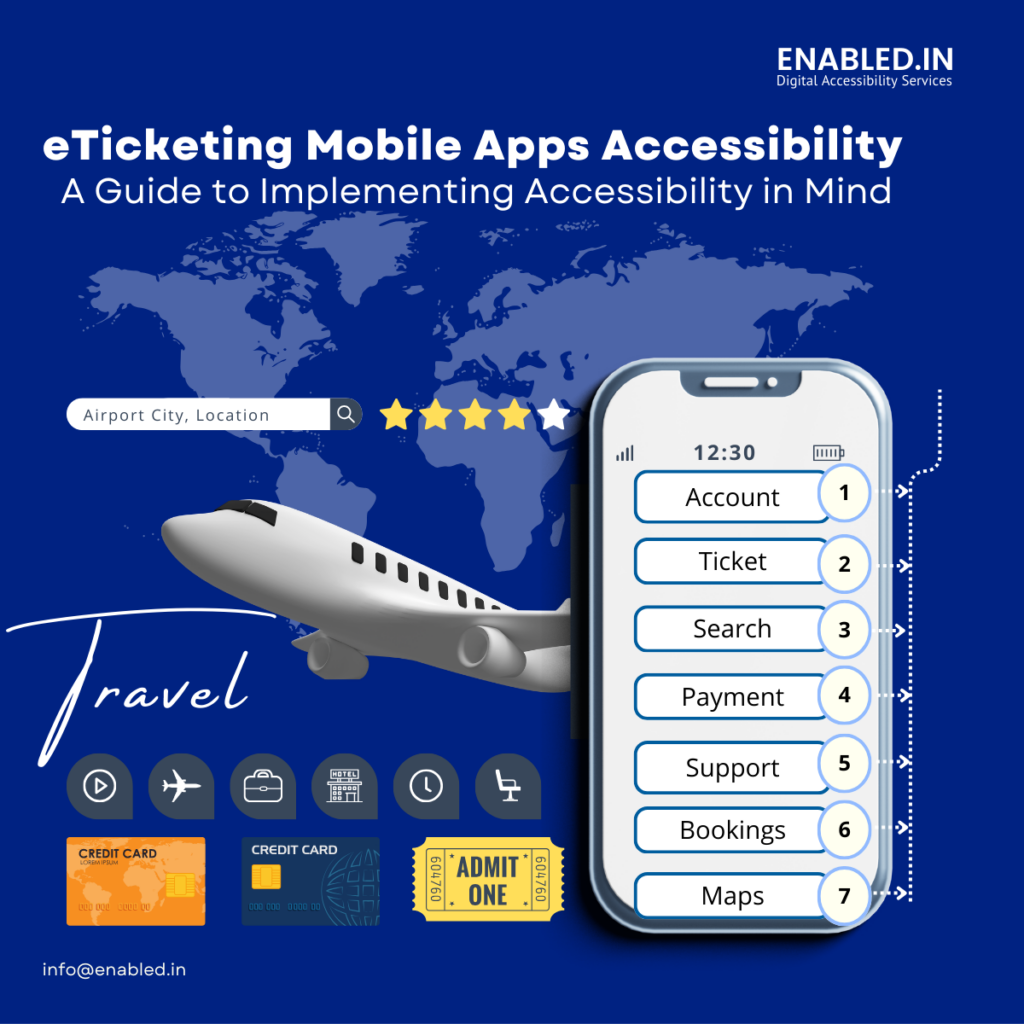Accessible E-Ticketing Mobile Apps : Building an accessible eTicketing app isn’t just a matter of compliance; it’s an ethical imperative, a business advantage that expands your user base, and contributes to a more inclusive digital society.

So, how can you ensure your eTicketing mobile app provides seamless access for all users? Let’s explore the key areas and how to implement accessibility features in each section:
1. Accessible User Account and Management
The first interaction a user has is often creating or logging into an account. Accessibility here is crucial:
- Screen Reader Support: All input fields (email, password, name, etc.), buttons, and links must have clear, descriptive labels that screen readers like VoiceOver (iOS) and TalkBack (Android) can read aloud. Use appropriate semantic roles to identify interactive elements correctly.
- Keyboard and Focus Navigation: Users who cannot use touch gestures should be able to navigate all forms and options using a keyboard or switch device. Ensure a logical tab order and a clear visual indicator showing the currently focused element.
- Clear Error Feedback: Validation errors must be clearly identified and explained in plain language, with specific guidance on how to correct the input. Error messages should be announced by screen readers.
- Flexible Input: Offer options like password reveal for easier typing and ensure input fields support various accessibility keyboards or input methods.
2. Inclusive Ticket Search and Booking
Searching for and selecting the right ticket should be a smooth process for everyone:
- Perceivable Search & Filters: Search input fields need clear, spoken labels. Filtering options (checkboxes, dropdowns) must be fully navigable and understandable via screen readers. Clearly communicate which filters are active and provide an easy way to reset them.
- Accessible Event/Service Details: Provide alternative text for all informational images and trailers. Ensure text content has sufficient color contrast and supports dynamic text resizing. For complex layouts like seating maps, offer an accessible alternative view (e.g., a list) that provides the same information and functionality.
- Simple Selection: If visual selection is used (like picking seats on a map), ensure each selectable element is focusable and its status (available, selected) is clearly announced to screen readers.
3. Navigable Payment and Transactions
The payment process requires trust and clarity. Accessibility builds both:
- Clearly Labeled Options: All payment method selections, input fields (card number, expiry, CVV), and buttons must have clear, descriptive labels for screen readers.
- Secure and Understandable Input: Handle secure input fields appropriately with screen readers (often announcing the field type without reading sensitive data). Clearly indicate required fields and expected formats.
- Accessible Review: The transaction summary before final confirmation must be fully accessible, allowing users to review all details before committing.
- Clear Feedback: Provide distinct visual and auditory cues for successful or failed transactions, with descriptive error messages for the latter.
4. Accessible Ticket Access and Usage
Using the digital ticket should be straightforward at the point of entry:
- Readable Digital Ticket: Ensure all critical information on the digital ticket (event name, date, time, seat, etc.) is displayed with high color contrast and supports text resizing. This information must be fully accessible to screen readers.
- Reliable Validation: While QR codes are common, ensure they are implemented following accessibility guidelines (e.g., sufficient size, contrast) and that staff are trained to assist users if scanning directly from the device screen is problematic due to assistive technology overlays or screen protectors.
- Offline Capability: Clearly inform users if and how they can access their tickets without an internet connection.
- Wallet Integration: Ensure the process of adding tickets to native mobile wallets is clearly labeled and easy to use.
5. Managing Bookings and Staying Informed
Post-booking features enhance the user experience and require accessibility:
- Accessible Booking History: Present past and upcoming bookings in a well-structured, navigable list that screen readers can easily interpret.
- Clear Management Options: Ensure options like cancellation or modification are clearly labeled and the process is easy to follow, with all confirmation messages and details being accessible.
- Customizable Notifications: Allow users control over the types and timing of notifications and reminders. Ensure notifications are delivered via accessible native system features that respect user preferences (visual, auditory alerts).
6. Accessibility in Additional Features
Any extra features should also be built with accessibility in mind:
- Accessible Maps and Location: If maps are used (e.g., for venue location or train routes), provide accessible alternatives like text-based directions or integration with native mapping applications that have built-in accessibility features.
- Inclusive Feedback: Make the process of providing ratings or reviews accessible to all users.
- Accessible Support: Ensure access to customer support options (chat, FAQ) is clearly labeled and the support interface itself is accessible.
- Clear Promotions: Present promotional content distinctly and ensure it doesn’t interfere with core app functionality or accessibility features.
Overarching Principles for Success
Accessible E-Ticketing Mobile Apps Beyond specific features, several general principles are vital:
- Adhere to Guidelines: Follow established accessibility guidelines like WCAG 2.1/2.2 AA standards for mobile applications.
- Prioritize Color and Contrast: Never rely solely on color to convey information. Use sufficient contrast for all text and graphical elements.
- Design for Flexibility: Support dynamic type, different screen orientations (unless essential), and keyboard/switch navigation.
- Provide Clear Communication: Use simple language, descriptive labels, and helpful error messages.
- Test with Real Users: Conduct usability testing with individuals with various disabilities to identify and address real-world challenges.
- Integrate Accessibility Early: Incorporate accessibility considerations from the very beginning of the design and development process, not as an afterthought.
Ready to Build an Inclusive E-Ticketing Experience?
Start by auditing your current app’s accessibility, train your design and development teams on best practices, and make accessibility a continuous part of your development lifecycle.
Build a ticketing experience that truly works for everyone. Start your accessibility journey today.
Contact us or email to info@enabled.in